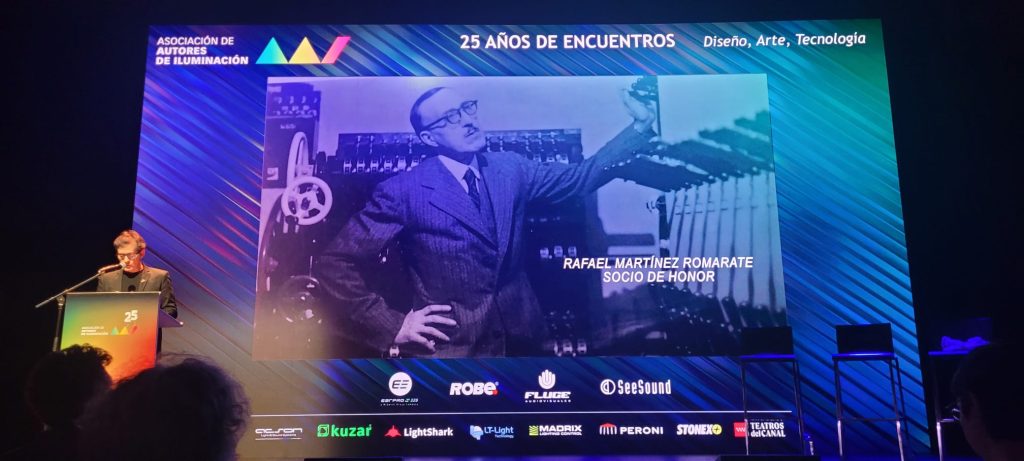Within the event“Design, Art, Technology 25 YEARS OF ENCOUNTERS“, the Association of Authors of Illumination and Video Scene has posthumously named as honorary member, the illuminator Rafael Martínez Romarate.
The concept of lighting design in theatrical staging, as we understand it today, is the result of an evolution throughout the history of Spanish theater. It was a long, slow process, determined by the complex history of the country. Therefore, the figure of the theatrical illuminator and its development was the result of the modernization effort, initiative and artistic passion of many professionals, among whom the capital figure of Rafael Martínez Romarate stands out, being the first illuminator of the Spanish theater that, in the forties, combined technical and artistic knowledge.
Romarate fled from preconceived ideas about lighting technology and was aware of the error that leads in staging to use light with the idea of illuminating. For him, some principles were very important and he carried them as dogma in his works: shadow, penumbra and darkness, three ways of conceiving the design of light provided by chiaroscuro. His figure is key to the consolidation of the concept of lighting design in the Spanish scene and to the emergence of a new professional role that makes it possible: the lighting designer.
In 1886 Rafael Martínez Romarate was born in Palencia, his childhood was spent in his hometown or in the farm El Carrascal, which his family had twenty kilometers from Palencia. He studied at the School of Industrial Engineering in Madrid. In 1909, he met Pilar de Valderrama – Machado’s Guiomar – at the performance of Wagner’s opera Tannhäuser at the Teatro Real. They marry in 1911. He travels to Venice in 1924, invited to the opening of the exhibition of his brother-in-law Victorio Macho, meets Mariano Fortuny, discovering the invention of the Fortuny Dome and, from that moment on, his way of understanding the scenic space changed and the way of interpreting lighting technology.
Romarate joined the Teatro Nacional (1940) when Luis Escobar was appointed director of the Teatro Nacional, he called him to take charge of the lighting of his productions and organize the technical sections by categories or trades. In addition to being the first illuminator of the Spanish theater, he was also the first technical director at the María Guerrero Theater, giving a new identity to the staging as a whole.
The recognitions to his work as a lighting designer were very important and came from theater personalities of his time such as Marqueríe, Buero Vallejo, Calvo Sotelo, Escobar… Dedications like “For Romarate, who made the light of the stars and the blindness of the spectators. With a hug from a good friend. Buero Vallejo. Madrid 18/XII/51”, premiere of En la ardiente oscuridad. Or “To Rafael Martínez Romarate: sculptor of light who has done so much for the regeneration of the stage in Spain. And also to his family, which is all poetry and pure art, with Marqueríe’s devoted admiration and deep affection”. Dedication of his book Cuando cae el telón.
Romarate opened research paths for future light and deeply influenced directors such as Adolfo Marsillach, José Luis Alonso or Miguel Narros and, through them, a generation of technicians/illuminators who conceived light as a score that had to be developed. Reflection, as the means to conceive the visual idea, the technique to develop it, the knowledge in the development of the light score. The word that encapsulates all of the above would be: luminoplasty.
The method of lighting at the National Theater was consolidated by the way of working with light; it was done by analyzing the text and finding in it references to create a dramaturgy that involved a journey of images with a content coupled to the proposed direction.
His artistic personality grew with his work, light was his writing; how reflective the gaze becomes from the distance of a stalls’ patio when one looks for what to do with the luminaries placed behind the batteries, and to put together different colors with different intensities, that is, working in and for the staging. A bourgeois, conservative and catholic man, he said that he was in love with lanterns, the night, drama and verses. His vocation was theater, his nature was light; candlelight, warm color, those lights that drip the wax of the great yellowish and cathedral candles.
Miguel Angel Camacho


